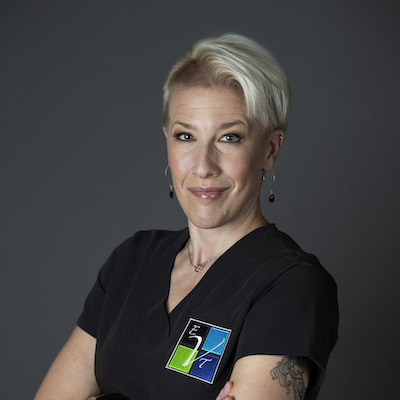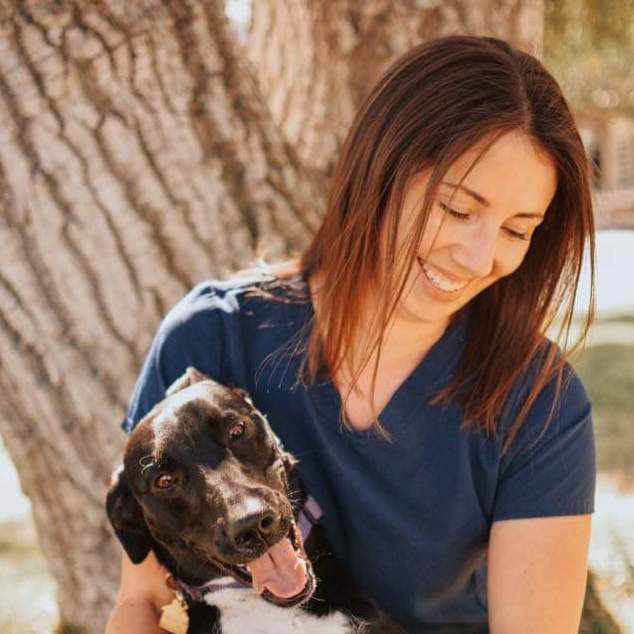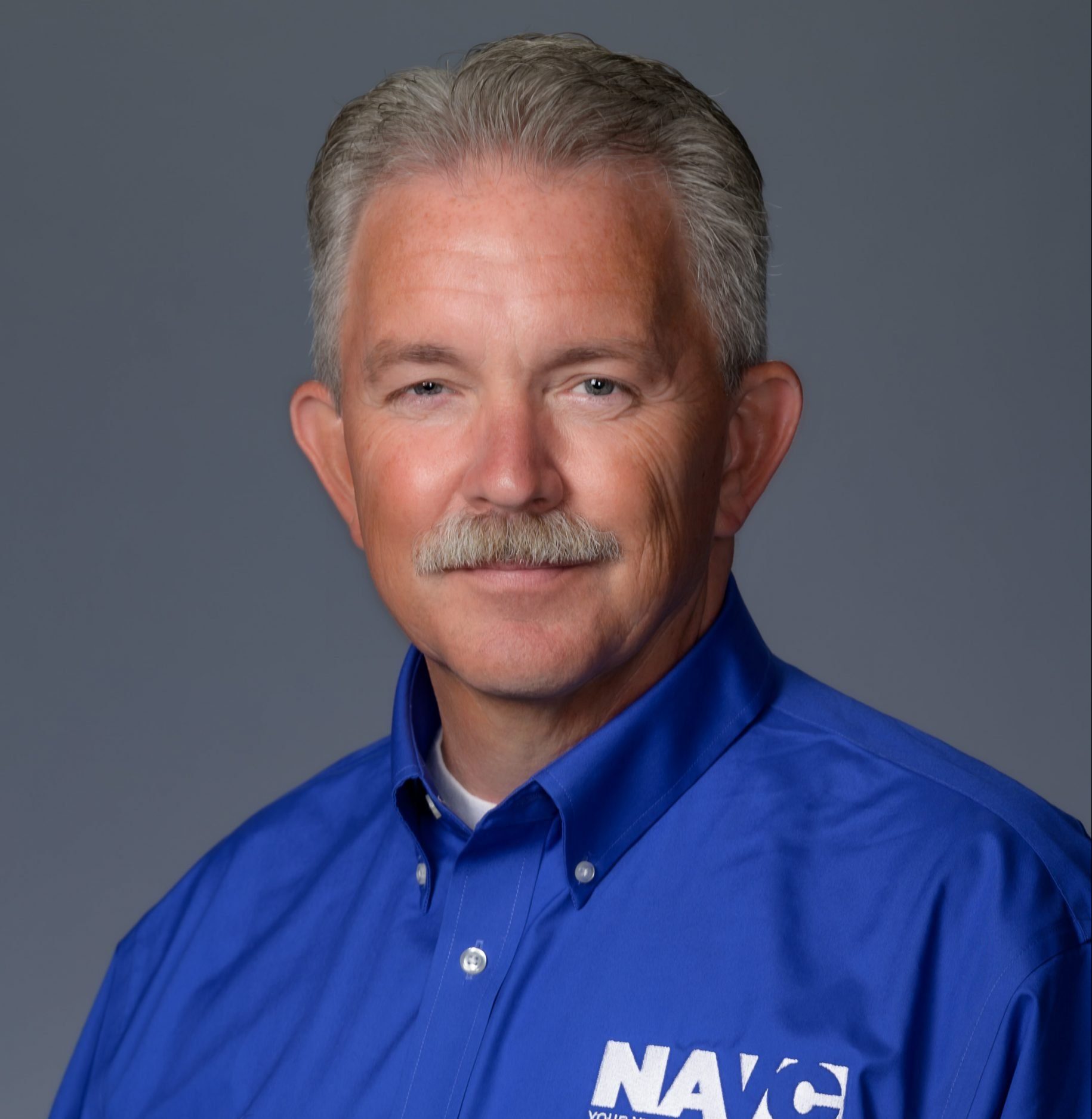table of contents
2. Unhealthy practice culture
3. Unclear position titles
a. LVT vs. RVT vs. CVT
b. Assistants vs. technicians
c. Nurses vs. technicians
4. Lack of educational understanding
5. Non-standardized credentialing
a. Credentialing
b. Role & responsibilities
c. Title protection
6. Lack of a career ladder
a. Healthy hospital culture
b. Understand technician education
c. Empower technicians
d. Distinguish between assistants & technicians
2. What we can do as an industry:
a. Standardize credentials
b. Add to DVM curriculum
c. Bestow title protection
d. Extend allowed functions of techs
e. Create a new advanced practice role
Let’s start by acknowledging that veterinary technicians are awesome.
They are the beating heart of our veterinary practices. They build trust and rich relationships with our clients, advocate and care for our patients, and give so much of themselves physically and compassionately to every shift.
But, as an industry, we haven’t been serving them as well as they serve our clients & patients.
Their position has been poorly regulated, the various titles are confusing, and their responsibilities vary wildly from practice to practice.
On top of this, our industry as a whole is facing staffing shortages, unprecedented employee burnout, and decreasing access to veterinary care for pet owners.
It’s time for a change.
To truly deal with the crisis, we must meet the needs of our industry head-on (and together).
In our “future of work” series, we’ll be highlighting how veterinary medicine can come together and modernize the experience of everyone.
For our first guide in this series, we decided to rally collaborators from across vet med & focus on one of the biggest talent pools in our industry: veterinary technicians.
In this guide, we lay out:
- the current challenges we face in regard to veterinary technicians
- the potential solutions to combat these current challenges
- the expected benefits when we start implementing some of these solutions (both in our practices and as an industry as a whole)
So, let’s jump in.
What are some of the current challenges veterinary technicians face?
To fix a problem, we must first understand the current landscape and its root causes. Below, we’ve outlined 6 of the largest challenges our industry faces when it comes to technicians.
1. Staff shortages
According to the U.S. Bureau of Labor Statistics, vet med position needs are growing faster than the average across industries.
Particularly, veterinary technician positions are growing at a rate of 15%, with 17,100 new positions to fill by 2030.

But, that’s just looking at the raw workforce numbers.
If we dive deeper into the actual needs of veterinary medicine, the problem compounds.
Data presented at the 2019 AVMA Economic Summit projected an increase of 33% in pet healthcare spending in the US over the next 10 years.
So, let’s add a 33% increase in veterinary professionals (to fill that need) into the equation.
Now, by 2030, there will be 54,912 new positions to fill.
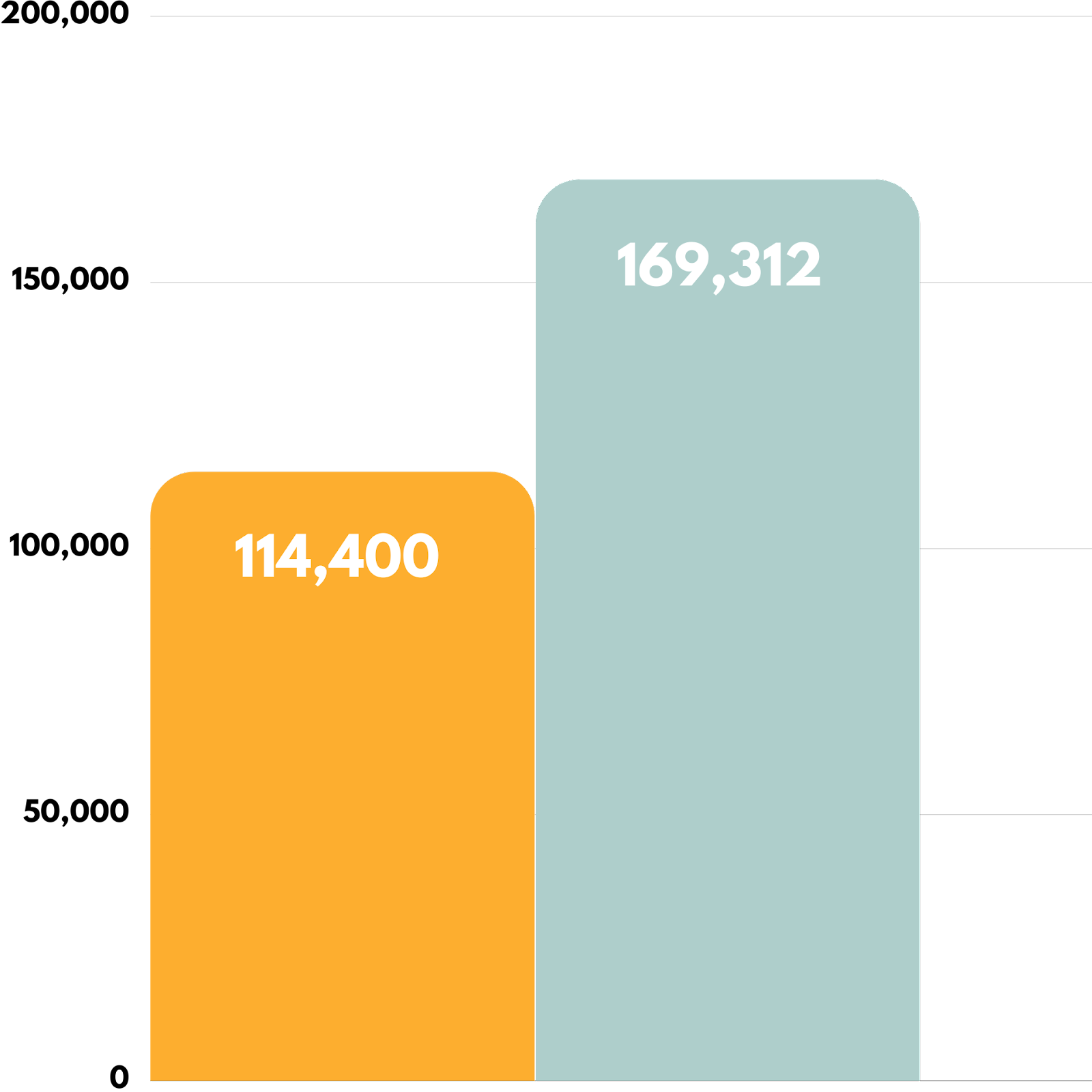
But, we also know that the current ratio of credentialed technicians to DVMs is about 2:1 in the U.S. And, we know from 2018 research, that the ideal ratio is closer to 4:1.
So, even if we bump that ratio up to a more conservative 3:1, we still see a massive gap.
By 2030, we’d need to fill an additional 132,885 positions.
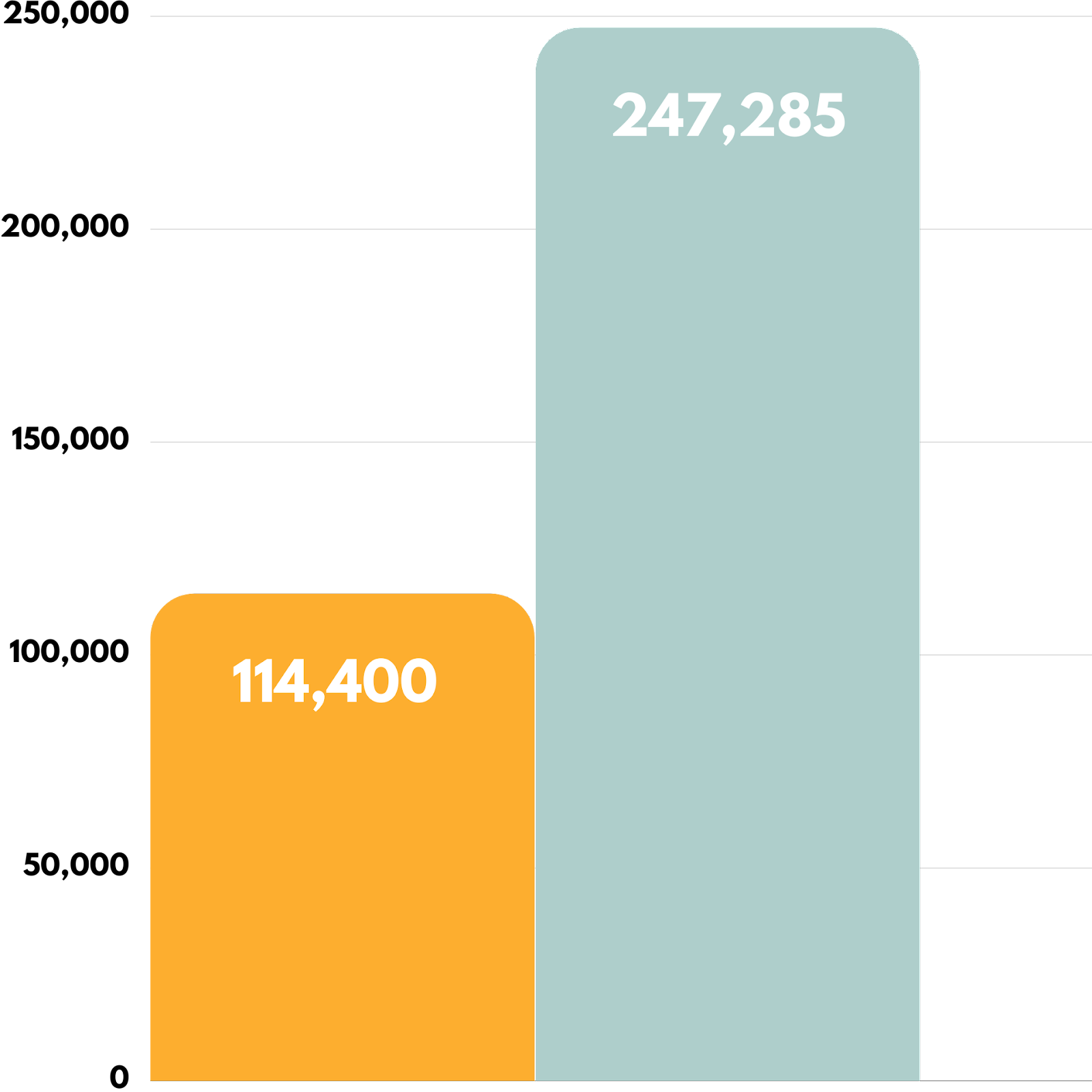
That’s more than double what we’re estimated to have today.
So, even if you’re not currently feeling the strain in your practice, soon every practice in the country will be feeling it if we don’t do something.
Which often, leads to the next challenge: practice culture.
2. Unhealthy practice culture
We also did some of our own research. At VMX 2022, we surveyed attendees about how they felt about their practice culture and, well…we’ll let you see the results for yourself.
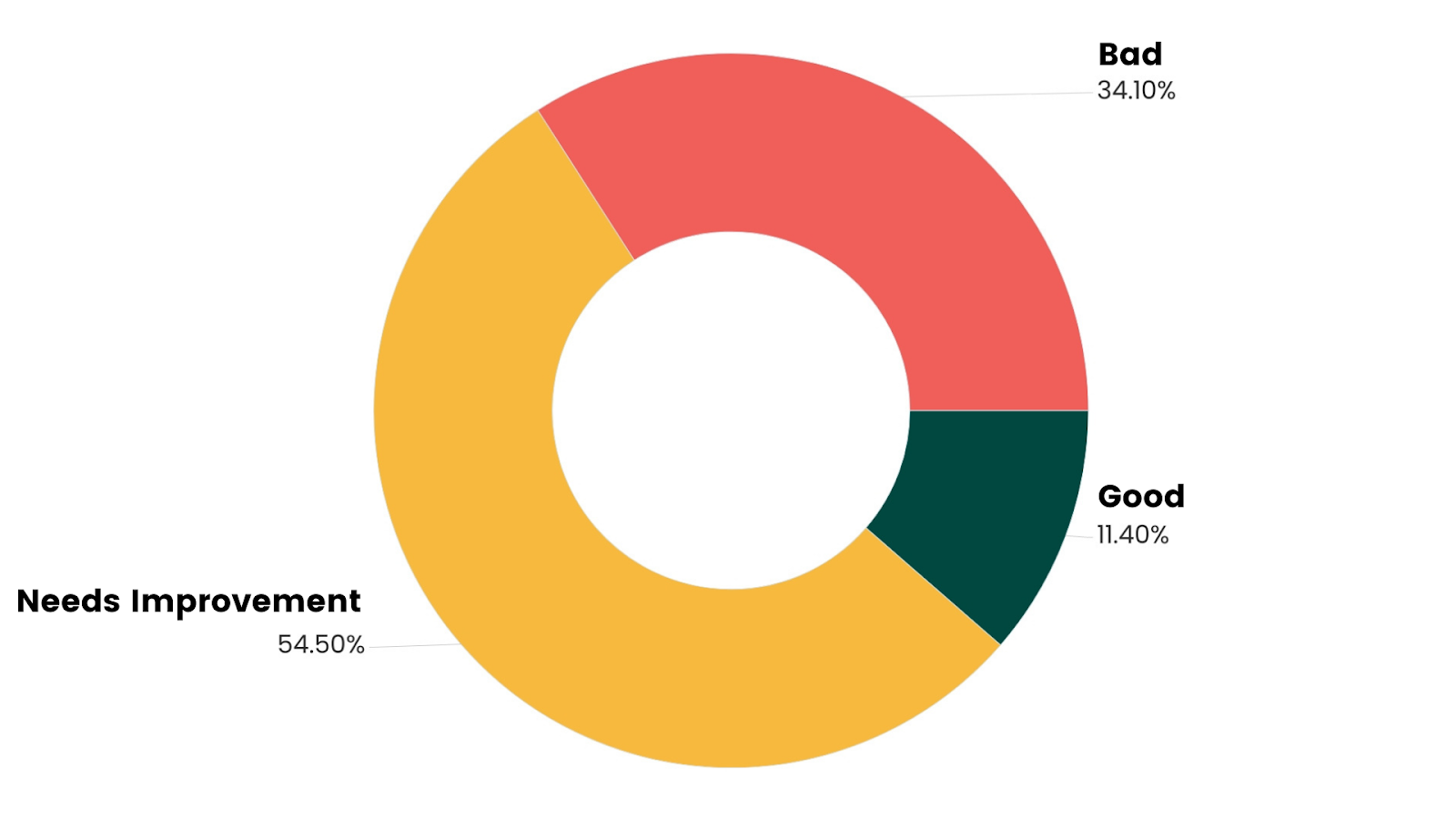
Only 11% of survey respondents said they feel the culture is good. Which is…not good.
And, when asked what they would improve, we initially thought this would be focused really heavily on burnout and compensation. But, we were surprised.
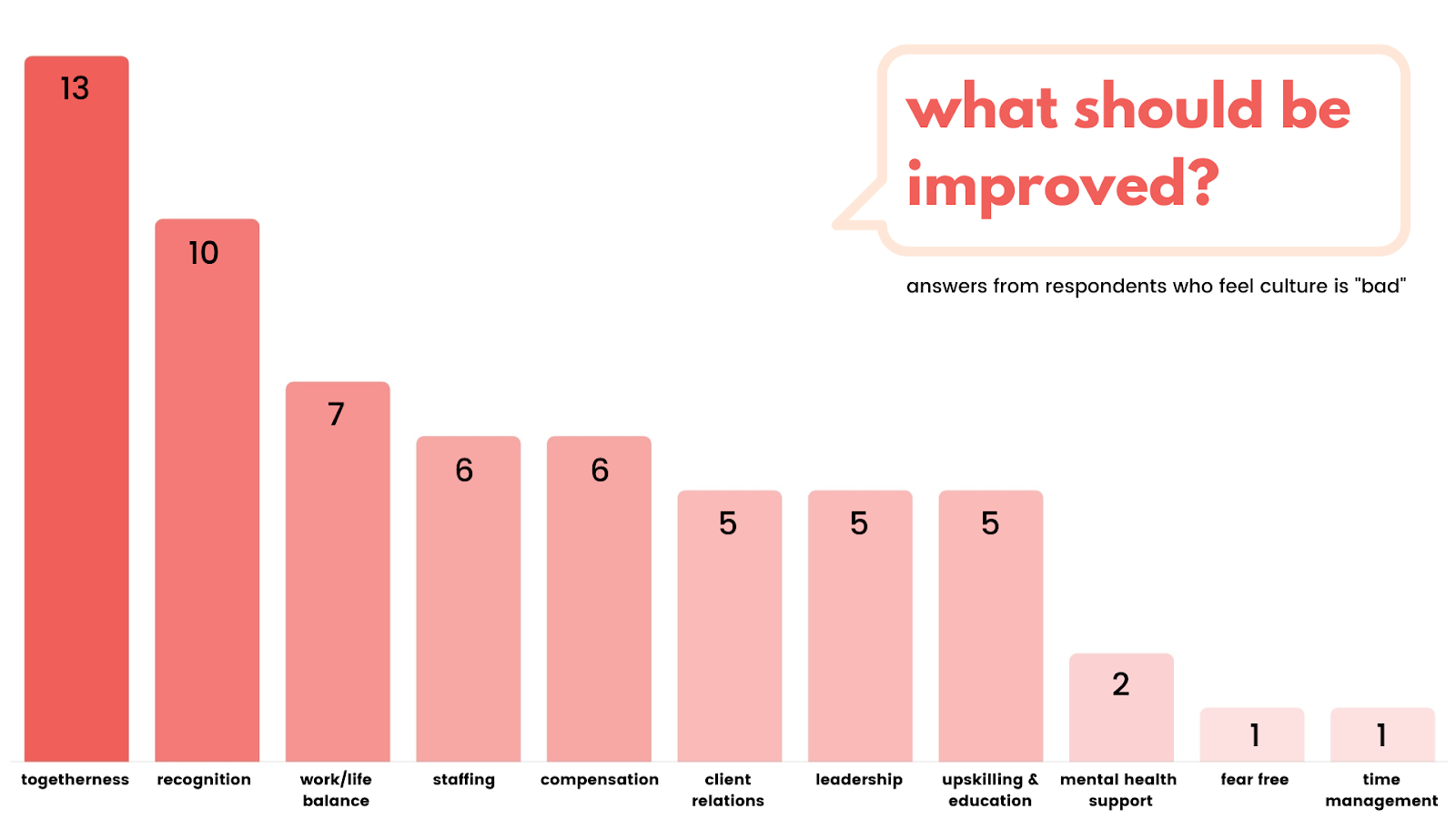
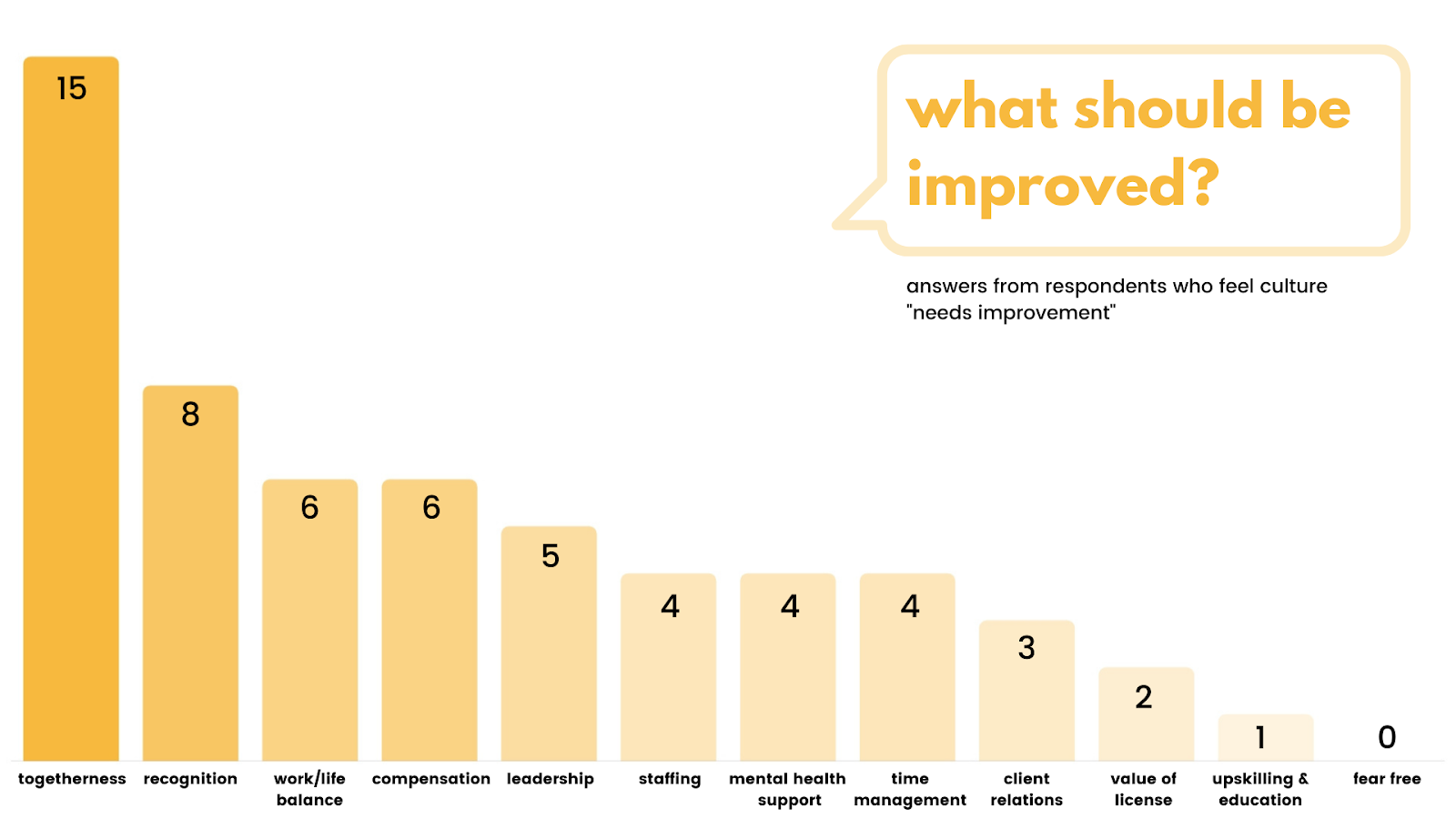
Respondents overwhelmingly focused heavily on cultural aspects of their practice — with togetherness and recognition being the top priorities for them.
And, on the flip side, respondents who said they thought culture was good had similar responses.
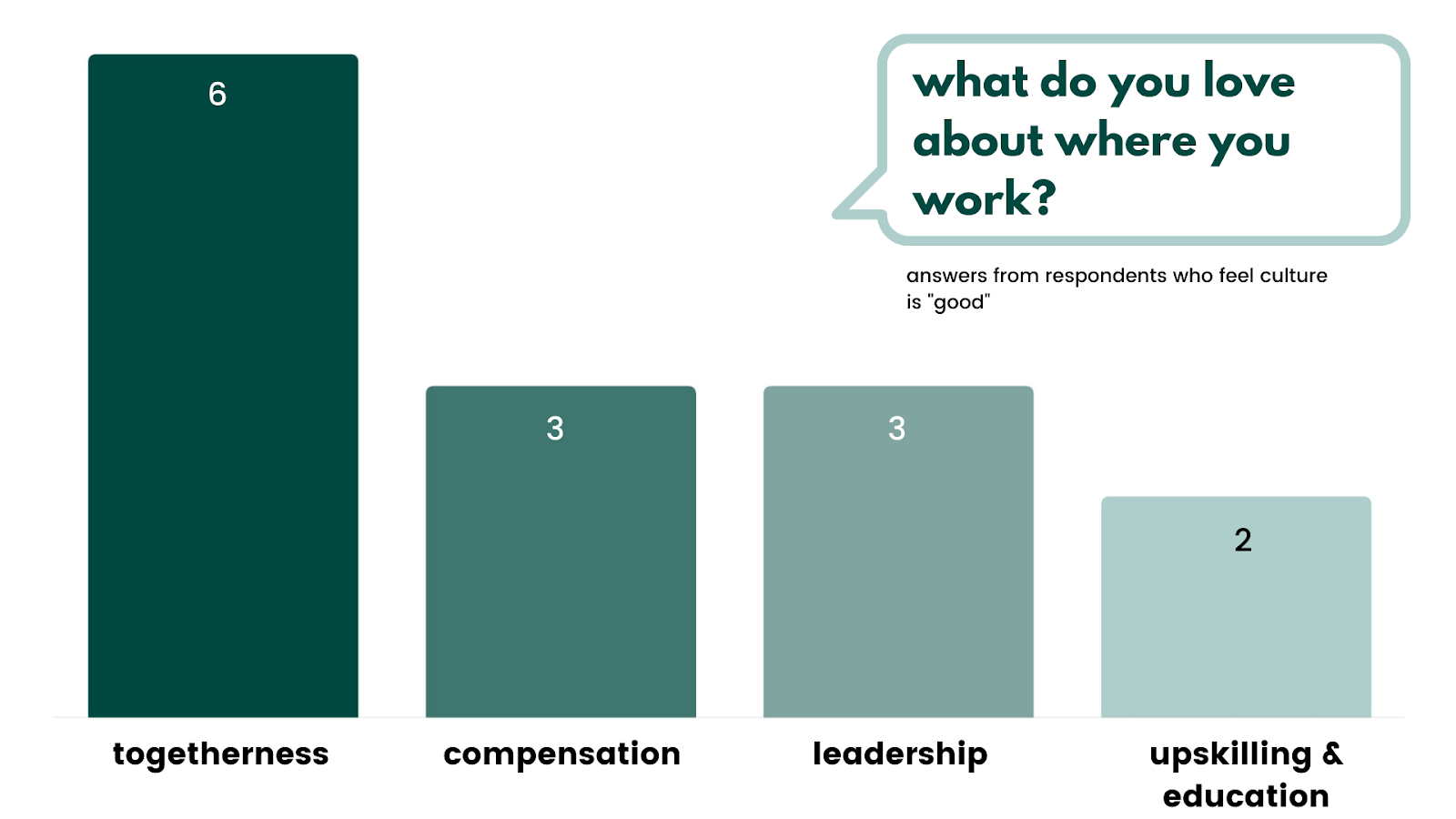
The takeaway?
Your practice culture is everything.
Caring deeply for your employees and creating an excellent work environment for them should be your top priority.
3. Unclear position titles
Another issue is the unclear titles veterinary technicians have. The nomenclature for this part of the profession is all over the place.
So, let’s break it down:
a. What’s the difference between licensed (LVT), registered (RVT), & certified veterinary technicians (CVT)?
At a base level: licensed, registered, and certified veterinary technicians are all the same.
The reason for the different terms is that each state independently decides what the credentialing process looks like (and the term they specifically use).
But, in over half the states that use “Certified Veterinary Technician” as their nomenclature, credentialing isn’t even required to call yourself a veterinary technician.
So really, it comes down to little more than semantics, and what each state board and/or government process deemed correct.
…which can be super confusing.
Lucky for you, we created a quick chart of each state’s terms.
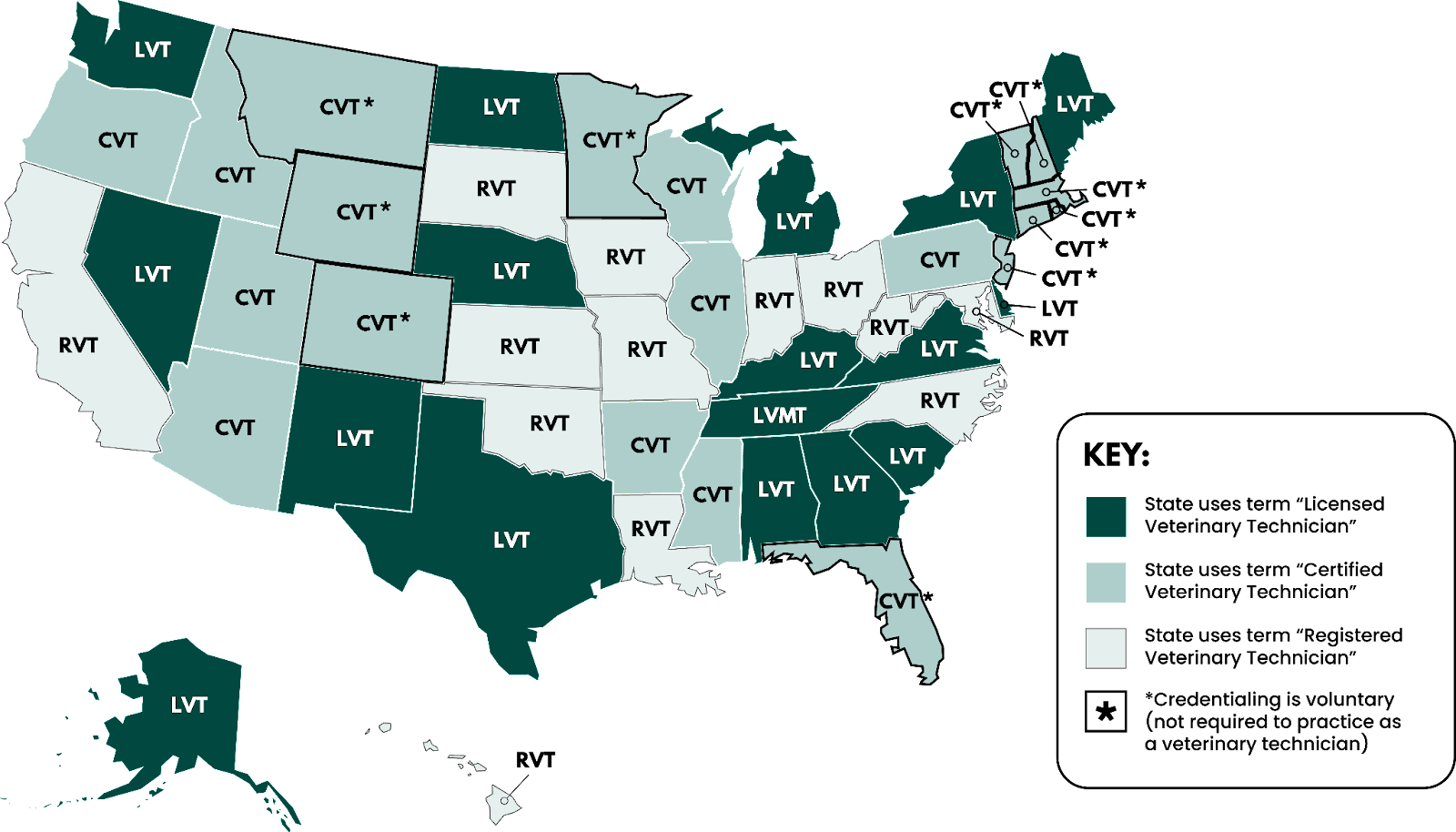
**Starting in 2023, credentialing is required in Colorado.
b. What’s the difference between veterinary assistants & veterinary technicians?
In most states, those who have not become credentialed as a Veterinary Technician are titled “Veterinary Assistants.”
These assistants typically have a more limited scope of duties and procedures they can administer than credentialed veterinary technicians (more on that below).
But in those 12 states where credentialing is voluntary, you can be called a veterinary technician regardless of your credentials.
…again adding to the confusion.
As Alyssa Mages notes, this lack of clarity, often referred to as title protection, also compounds this issue.
“Unfortunately, there are very few states in the US that recognize this distinction and have a protective clause written into the veterinary practice acts clearly delineating the roles of a veterinary technician as someone who is credentialed and a veterinary assistant as someone who is not.
This tends to be coupled with a negative connotation with the word assistant - which is unfair as these people are incredibly skilled & integral to the success of a practice.”
c. What’s the difference between veterinary technicians & veterinary nurses?
Veterinary Nurse is a newer term coined by the Veterinary Nurse Initiative. Their hope was to standardize the profession of veterinary technicians to a unified term “Registered Veterinary Nurse.”
In this vein, some professionals and practices have adopted this language in an unofficial manner.
When it comes to states and governing credentialing bodies, however, they all still recognize a form of “Veterinary Technician” as the official nomenclature.
Why don’t we change the name to veterinary nurse?
The Veterinary Nurse Initiative hit some roadblocks when trying to take this to the governing bodies.
The American Nursing Association stood against this nomenclature change, citing that human nurses have gained a level of respect and trust over the last century, requiring many years of schooling and strict guidelines to obtain the title of “nurse.”
Because of this, they were worried that veterinary technicians changing their title to “veterinary nurse” without the same rigor would tarnish the reputation human healthcare has worked hard to create.
What does the rest of the world call veterinary technicians?
North America is fairly united in its use of “Veterinary Technician” as the official term today, but the rest of the world isn’t necessarily on that same page.
In the UK, Ireland, Australia, New Zealand, and most of Europe, the common term is Veterinary Nurse. Although Europe has a similar issue as the U.S., where title protection and regulation of the profession are seemingly all over the place.
4. Lack of understanding of what credentialed technicians are taught
Peg Wheeler lays out the current issue with this for us:
"In my work with students in practicum sites and then following them as they start their careers, it has become clear to me that many practice owners, managers, and veterinarians have little clarity on what the AVMA/CVTEA require veterinary technicians to know in order to graduate and take the VTNE.
I have interviewed/hired many veterinarians for veterinary technician educator positions, and almost without fail, they will at some point say, ‘I had no idea they needed to know how to do this!’
Veterinary Technician training is consistent across the country, and so it should be a realistic expectation that all veterinary teams would understand the scope of skills that their credentialed veterinary technicians are trained to perform.
I have heard veterinarians say things like, ‘If I could train my Veterinary Technicians to … then I could use them for exams and rechecks,’ and 99% of the time, I can comfortably respond that they are trained to do those things."
What are the veterinary technician credentialing programs?
Professionals looking to get credentialed typically have two options:
- A 2-year Associate’s Program
- A 4-year Bachelor’s Program
Throughout the US, there are more than 200 accredited institutions, both online and in-person, that conduct these programs.
What do veterinary technicians learn to do in school?
Bonnie Price gives us a deep-dive.
"The AVMA Committee on Veterinary Technician Education and Activities (CVTEA) develops the standards that guide veterinary technician program curricula. The CVTEA’s Veterinary Technology Student Essential and Recommended Skills List is a master list of motor, clinical application, and critical thinking skills.
The list contains a number of required hands-on (psychomotor) skills that must be performed by every technician student, some hands-on skills that can be performed in a group, and some skills that need only be demonstrated to students.
In addition to the psychomotor skills, the list contains an extensive number of knowledge-based skills that can be taught in a more traditional lecture style setting. Every veterinary technician, veterinarian, and hospital manager should be familiar with this list.
The list can help practices establish reasonable expectations for new graduates, and develop skill building programs within the practice to help technicians advance motor skills that were not required hands-on skills in schools.”
5. Non-standardized credentialing
a. What is required to become a credentialed veterinary technician?
To officially get your credential, in most states, you must successfully complete and graduate from an AVMA Accredited Veterinary Technician Program, take and pass the Veterinary Technician National Exam (VTNE), administered by the American Association of Veterinary State Boards (AAVSB).
Then, once you pass, you must submit your scores to your state and go through their processes.
For a quick guide to each state, we’ve linked each state's credentialing requirements pages below:
AL | AK | AZ | AR | CA | CO | CT | DE | FL | GA | HI | ID | IL | IN | IA | KS | KY | LA | ME | MD | MA | MI | MN | MS | MO | MT | NE | NV | NH | NJ | NM | NY | NC | ND | OH | OK | OR | PA | RI | SC | SD | TN | TX | UT | VT | VA | WA | WV | WI | WY
b. What are credentialed veterinary technicians allowed to do?
You guessed it, this also varies state by state.
Are you sensing a theme here? 😉
Each state has a “State Practice Act,” which are legislative acts & regulations issued by a regulatory agency such as a State Board of Veterinary Medicine. And each state’s practice act is unique.
However, as Alyssa Mages outlines…
“Legally, there are only 4 things that we cannot do:
- prognose
- diagnose
- prescribe
- perform surgery
We can do anything and everything in between, and we do. Phlebotomy, anesthesia, chemotherapy administration, minor wound repair, critical patient care, triage, advanced calculations (IVF, CRIs, etc.), radiology (imagery, tFAST, aFAST scans) - the sky is literally the limit. We simply need the resources & the support within our practices to showcase our skills.”
What are the differences between states?
Let’s use neighboring states, Alabama and Georgia, as an example.
For instance, in the table below we’ve laid out what Alabama’s state law allows unlicensed assistants to perform, as opposed to licensed technicians:
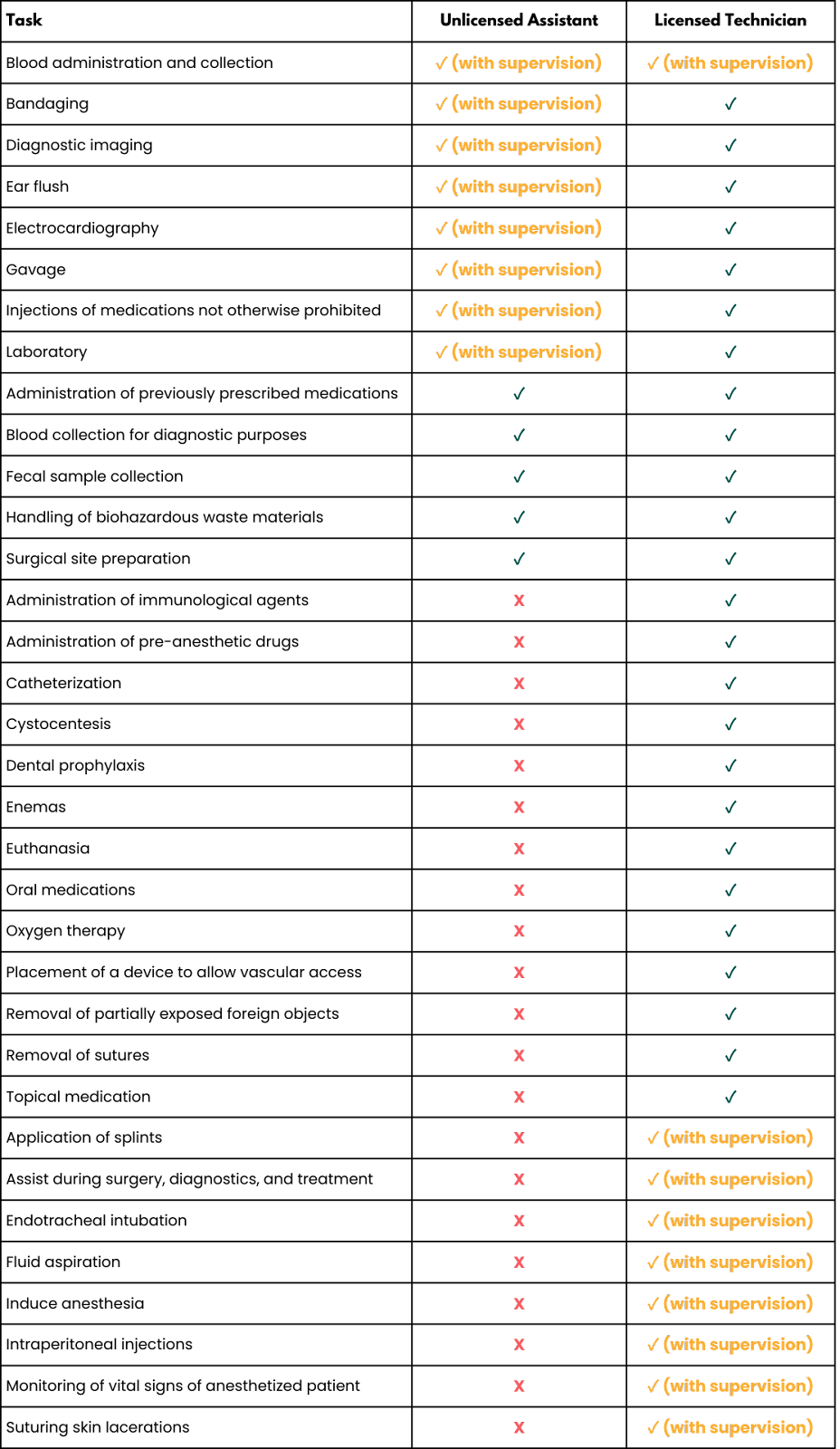
A lot of granularity and caveats there.
And while a lot of states are similar (although, often not as detailed) in their designations, it’s not the exact same.
Let’s take Alabama’s next-door neighbors in Georgia as our next example.
Technically, they allow licensed technicians to perform any task delegated to them under the supervision of a licensed veterinarian. And, that’s all the law says about it. No granularity, just up to the discretion of the veterinarian they’re working for.
So, if you’re thinking of moving out of state, it’s important to check up on your state’s laws & procedures.
c. What is title protection?
Amy Ramirez breaks this all down for us:
“Title protection refers to each state's preferred title within the practice act that provides specific protection, regulation, and restrictions in using the title ‘veterinary technician’ within each state.
Many states have outlined specific educational requirements, the scope of practice, and title protection, while others have yet to provide guidance.
Currently, 19 states do not provide title protection for veterinary technicians.”
Why does title protection matter?
Amy Ramirez also elaborates on this for us:
“The title ‘Veterinary Technician’ is used inconsistently and, oftentimes, incorrectly, and suffers from a lack of clarity and understanding, both within the veterinary world and among consumers.
For example, a consumer may not know the specific differences between licensing requirements for registered nurses, physician assistants, or nurse practitioners, but consumers have an underlying understanding that there is a standard of professional education that individuals with these titles hold.
This same understanding needs to exist for the veterinary profession, where Veterinary Technicians are clearly differentiated from Veterinary Assistants and other paraprofessionals on the veterinary team.
As a consumer, the expectation when ‘veterinary technician’ is used is that the individual has had the appropriate education, training, and experience to provide care accordingly and provides the structure going forward to create uniformity and cohesion across the profession.
The end result of title protection is a title that is transferable across states with corresponding consistency of expectations regarding education, training, and the passing of a credentialing exam such as the VTNE.
This consistency will result in a more sustainable future for veterinary technicians across the industry, a career pathing that creates sustainability and pay ranges that move to support a more financially secure future.”
6. Lack of a career ladder
So, once you’re credentialed, what’s next?
Some technicians opt to go into specialties and obtain their Veterinary Technician Specialist (VTS) credentials. Those specialties include:
- VTS (ECC): Emergency & Critical Care
- VTS (Dentistry)
- VTS (IM): Internal Medicine
- VTS (Anesthesia & Analgesia)
- VTS (Zoo): Zoological Medicine
- VTS (Clinical Practice)
- VTS (Clinical Pathology)
- VTS (Nutrition)
- VTS (LAM)*: Laboratory Animal Medicine
- VTS (Ophthalmology)*
- VTS (Dermatology)*
- VTS (Surgery)*
- VTS (DI)*: Diagnostic Imaging
(*these programs all have provisional recognition, as opposed to full recognition)
What if you don’t want to specialize?
Some opt to take on leadership roles in their practices, whether that’s as a “lead” technician or on the operations side as a practice manager or recruiter.
Some go to work for corporate practices and lead technician initiatives across various portfolio practices.
But, if you still want to be with animals every day, there’s no real “next” step.
And, this distinct lack of a career ladder is compounded when we look at the human healthcare comparison that Bob Lester, DVM (Chief Medical Officer WellHaven Pet Health, NAVC President-Elect) provided us:
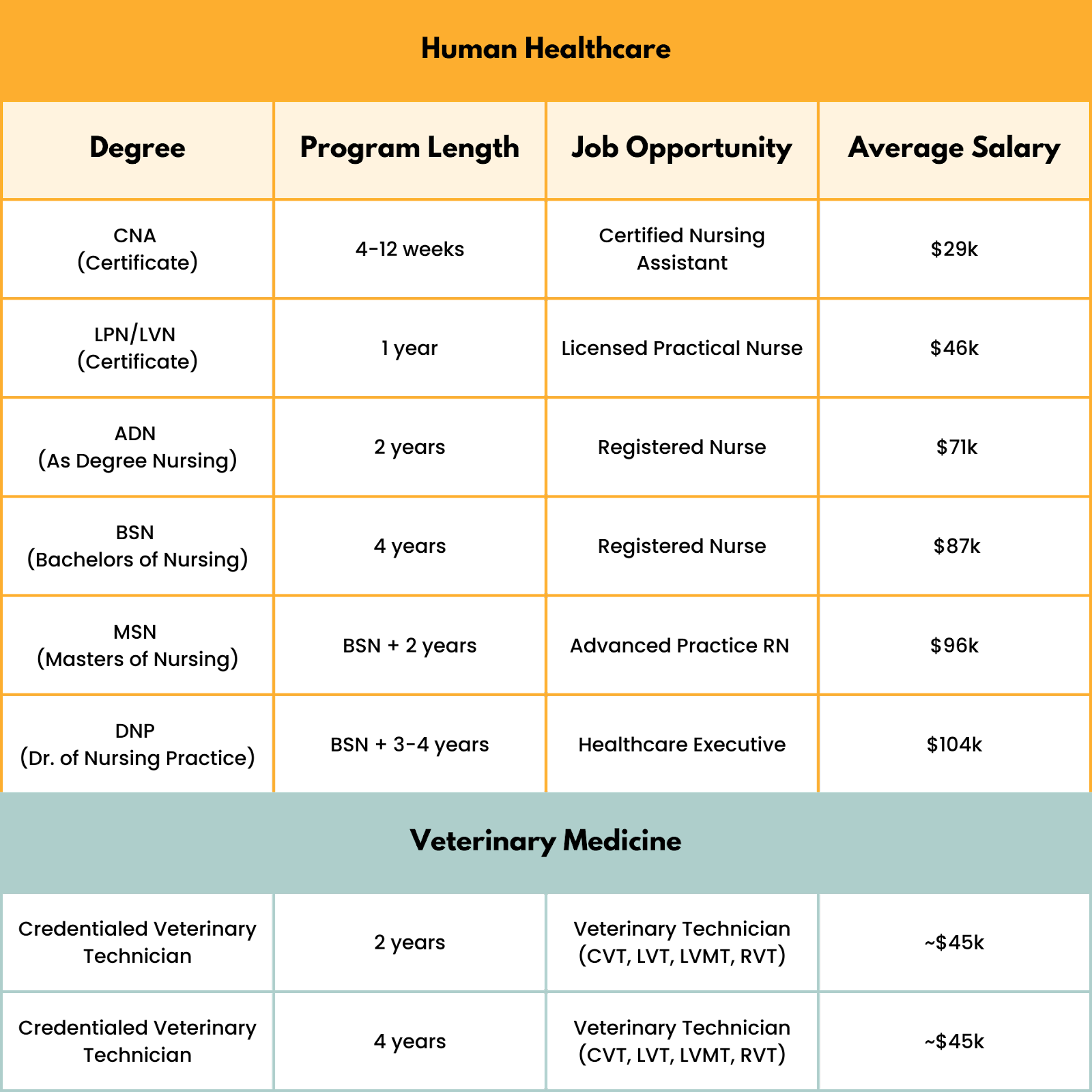
Human nurses, depending on their level of education, can earn well into six figures. That’s quite the incentive to continue schooling.
And, because of this pay scale, that continued schooling makes sense for them economically.
We can’t expect someone from a lower-income household to be excited about becoming a highly educated veterinary technician if we’re paying them just enough to stay afloat and then add student loans to their plates.
Niccole Bruno outlines this:
“There are many barriers for technicians (cost of tuition, exam, hourly wages) to become credentialed.
Also, if they do not pass their VTNE the first time (and many don’t - just like veterinarians taking the NAVLE) it can be expensive and prohibitive to try again.
I’ve worked with many technicians, those with credentials and without, and have learned a lot from both.”
How can we solve the current challenges in the industry?
We obviously have a lot to solve.
In order to figure out how we can solve some of these challenges, we brought in experts from across vet med — executives, veterinarians, current technicians, educators, and industry folks.
From their insights, we compiled 6 ways we can better the experience, both in our practices and more broadly across the industry.
1. What we can do now in our practices:
These are things we can start implementing today. In each of these sections, we’ve included a “best next step” to help you take action.
a. Cultivate a healthy hospital culture
First and foremost; you must take care of your people.
And, you must advocate for each other. If you’re a veterinarian (even if you’re a new grad or associate), you carry inherent authority and have a strong ability to support the advancement of veterinary technicians.
“Veterinarians need to position themselves as allies to veterinary technicians. We need to educate ourselves on the unique challenges the veterinary technology profession faces- from inconsistencies in credentialing state to state, lack of title protection, poor pay, lack of full skill utilization, to little opportunity for career growth and advanced education.
We need to ask technicians what they think the solutions are to these problems. We need to recognize the power and privilege that we as DVMs have in this field and use it to drive systematic change in this profession, starting with the practices where we work.”
Additionally, we need to look at our practice culture as a whole, as Alyssa Mages notes.
“The best way we can improve vet techs' experience in our practice is to support them — in every shape & sense of that word.
Provide programs & means to ensure that every member of the team is financially, emotionally, mentally (keep those brains full & skills sharp), and physically secure.”
We can do a lot of work for technicians specifically, but you can’t start putting an addition on a house if your foundation is shoddy.
To cultivate a healthy hospital culture, you need to review 3 key areas of your employee experience:
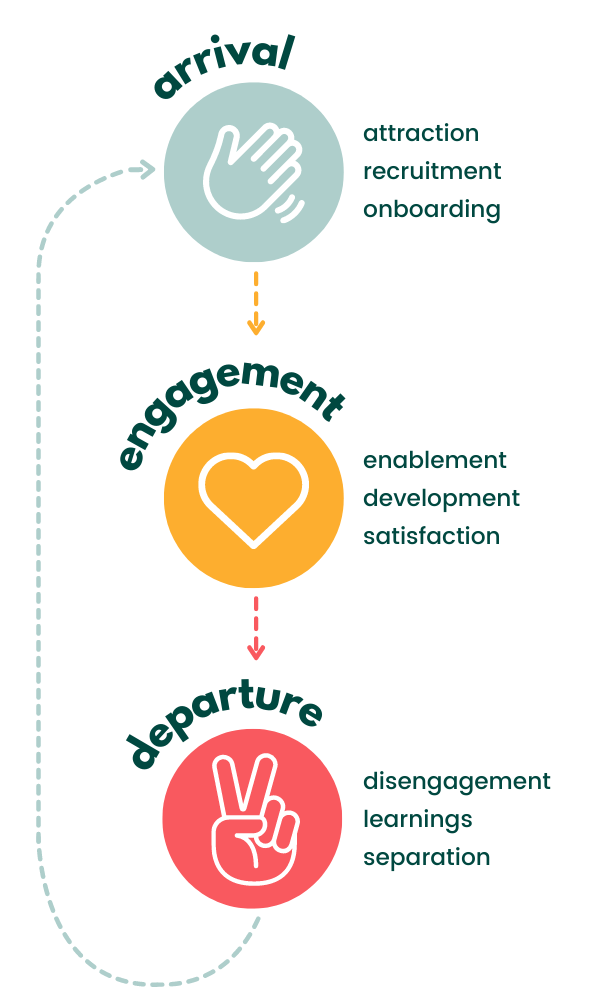
- Arrival: how can you attract new talent & set them up for success early?
- Engagement: how can you create safe environments for growth & fulfillment?
- Departure: how do you celebrate the journey of your employees?
Best Next Step:
Take an hour out of your day and read our Ultimate Guide to Awesome Culture in Veterinary Medicine. This guide outlines all the needed steps to create a better culture in your practice and gives easy, actionable steps you can take to improve it.
b. Gain a clear understanding of what your technicians are trained & allowed to do
We think you’d be surprised at how much your technicians are taught to do that you may not even realize.
“We need to focus on a significant campaign to bring an understanding of what Veterinary Technicians are consistently trained and expected to be able to perform after graduation and passing of the VTNE.“
As mentioned above by Bonnie Price, the CVTEA’s Veterinary Technology Student Essential and Recommended Skills List is a list of motor, clinical application, and critical thinking skills all veterinary technician students should know.
This list isn’t fully inclusive (and shouldn’t be viewed as the end game), but a starting point for new and recent grads. But, it is a good starting point to truly understanding if you're utilizing your technicians well — even at a base level.
We took this list and created a comprehensive worksheet to really hone in on the gaps between what your technicians are trained to do in schooling, and what you’re currently allowing them to do in your practice.
Best Next Step:
- Print out this worksheet, which outlines all the actions your credentialed technicians are trained to do through their schooling.
- Then, physically check off everything your technicians are allowed to do in your practice today.
- If some are left blank, pick 3 actions you can start empowering your technicians to do.
- As you get more comfortable, add more until the whole worksheet is filled in.
c. Empower technicians & nurses to perform at the top of their license
In a study from 2018, researchers found that veterinary practices, on average, only allow credentialed technicians to use about 30% of the skills & competencies for which they are educated.
So, what do technicians performing at the top of their licenses look like?
Well, we went straight to the source!
What does performing at the top of your veterinary technician license look like?
“It means doing the best for my patients at the time they need it, whether that means a new therapy on the cutting edge of critical care medicine or a conventional one, and being able to iterate options, benefits, and drawbacks to owners.
It means being able to advocate for my patient's best reasonably possible care.”
“Performing at the top of your license means doing the best you can by following the proper policies and procedures within your clinic.
It’s utilizing your education to best care for your patients without cutting corners.”
“Working at the top of my license is being able to do my job to the best of my ability when I can utilize all of my skills and knowledge, and perform a wide variety of tasks.
It’s also about being trusted to do the work I was trained to do.”
The consistent thread?
Having the autonomy and ability to use their education to the fullest extent.
How does this help your practice?
Amy Ramirez explains:
“Technicians working at the high end of their credentials drive the experience, treatment, and efficiency of the care team by providing services to the patient and their families.
This, in turn, makes it so they are:
- counted on as subject matter experts in their field,
- relied upon for their unique contributions to the veterinary profession,
- recognized for their advancement of biomedical research and biomedical engineering of patient care technologies and equipment.
This helps them find professional satisfaction in their work and remain engaged with their careers. In part, because they are paid well enough that they can sustain their family’s future without the necessity of working multiple jobs.”
Bonus: Offering technician-specific continuing education
Additionally, continuing education is often focused very heavily on doctor education and less so on technician education, as Adam Parrish lays out:
“A better technician experience comes with education, whether that be in the form of more technician-focused classes after our degrees or through more focused technician CE training.
Our job, in addition to being the technical team, is client education. Pivotal to that goal is an understanding of the physiological response to disease and treatments, the necessity of diagnostics and therapeutic plans.
So far, many of us have had to rely on ‘doctor-focused’ CE training for this after our education. When clients see us in an educated light, it may begin to shift the narrative that stands that only veterinarians are educated about their pets and are capable of having meaningful discussions with them.”
Best Next Step:
Use the below questions to ask your technicians how they feel about their current duties.
- Do you feel you're using the full extent of your education at our practice?
- What could you be doing that you’re not allowed to do at our practice today?
This will give you a baseline of if your technicians feel they’re being utilized fully, and how you can better that experience for them.
d. Distinguish clearly between veterinary technicians & veterinary assistants
📌 With this section we’re talking specifically to those 12 states that don’t require credentialing.
For you, this distinction is a voluntary decision. But, you must be making this distinction between your assistants and technicians.
Why? Because you’ll be:
- utilizing your team’s skills much more effectively
- providing clarity to your clients
- honoring and supporting your assistants’ contributions much more
Peg Wheeler outlines this:
“A veterinary assistant’s role is separate from that of the credentialed veterinary technician, but it is just as important.
I intentionally use the words ‘separate and celebrate’ because the need to define each role separately is not meant to lessen the value of anyone but rather to create clear and correct titles that can be attached to effective job descriptions that create workflows that are best for the welfare of animals, the understanding and support for job growth, and for the profitability of the business.
We can better support these important team members by providing work environments that:
- provide clear job descriptions that clearly distinguish the roles and expectations of each team member and how they interact and work together,
- offer support for work/life balance,
- recognize the importance of the work they do,
- provide wages that are competitive,
- recognize the value they provide to the practice,
- provide opportunities for growth and continuing education.
Once we can all see with clarity how different titles are attached to critical roles that support each other and the care of animals, we next need to recognize exactly what each team member is trained (or not yet trained) to do.”
Best Next Step:
Update the titles in your practice (Veterinary Assistant vs. Veterinary Technician) to reflect & honor the credentials of your people.
Additionally, find room in your budget to offer to sponsor the credentialing of your assistants.
Tip: If you’re changing someone’s title from technician to assistant and still want to honor their experience and on-the-job knowledge, put “lead” or “senior” in their title.
2. What we can do as an industry:
a. Standardize credentials across the country
The first thing we desperately need as an industry is clarity.
And that clarity starts with making a standardized language around the role of the “veterinary technician.”
Peg Wheeler elaborates on this:
“I don’t think we can overstate how important it is to recognize the role and the importance of veterinary assistants.
There has been a lack of clarity about distinguishing veterinary assistants from veterinary technicians, but the increasing number of states that are passing rules or laws that provide credentialed veterinary technicians with title protection and scope of duty requires that the industry take on this issue consistently.
We need to provide a clear separation with a definition of the two roles & celebrate the importance of each relative to the success of the veterinary team.
Until we do this, the cloud of confusion between the two roles is going to plague the industry.
Because the position of Veterinary Assistant is one that is not attached to legislation requiring any specific training or testing, it is important to have a clear understanding of what Veterinary Assistants have had for training or experience.
But since there is no expectation for consistency in the level of training or education, the burden to understand this falls on practice management.
To do this, we must:
- Require credentialing to be named a “Veterinary Technician”
- Standardize the credentialing requirements across all states
- Create easy avenues for those who are not credentialed to become so (e.g. experience equivalents & VTNE sponsoring)
b. Add to the veterinary student curriculum to include technician utilization
“Educating veterinary students about the role of veterinary technicians is critical to ensuring that every member of the veterinary team practices at the top of their license. 'Utilize technicians' has become a bit of a catch phrase - veterinary students know they are supposed to do it, but do not uniformly receive training on what it means or how to do it.
The profession’s inconsistent use of the term veterinary technician has exacerbated the lack of understanding of the role of technician. Due to widespread lack of title protection for credentialed veterinary technicians, many non-credentialed individuals who go on to vet school have held the role of ‘technician’ in a veterinary practice. This lays a foundation for the future veterinarian’s understanding of the role of technician.
During school, little specifics are taught about how veterinary technicians are educated and what skills they bring to a practice. Finally, during clinical rotations, many veterinary students are tasked with technical work in busy teaching hospitals and practices - further muddying their understanding of who on the healthcare team should be doing what.
The role of technicians can easily be incorporated into every level of the veterinary school curriculum.
The AVMA COE requires that vet school curricula provide ‘opportunities throughout the curriculum for students to gain an understanding of professional ethical, legal, economic, and regulatory principles related to the delivery of veterinary medical services, personal and business finance and management skills; and gain an understanding of the breadth of veterinary medicine, career opportunities and other information about the profession.’ (Standard 7.9)
Many programs cover much of this in introductory courses the first year of veterinary school; the regulatory oversight of veterinary technicians and accreditation of technician programs (including essential skills learned in CVTEA accredited programs) could be introduced as well.
Moving forward in the curriculum, students should be given specific examples of how to leverage the skills of technicians during wellness appointments, sick patient visits, hospitalized patient management, etc.
- Clinical skills courses should clearly indicate what skills being learned can (and should) be performed by a credentialed veterinary technician when one is available.
- Business electives should provide training on incorporating technician appointments into practice.
During the clinical year, veterinary students would ideally be evaluated on their understanding of not just case management, but also their ability to leverage the entire veterinary team in the care of a patient.
c. Bestow title protection to veterinary technicians across the country
The clarity we’ll gain from standardizing the title can be further built on by bestowing title protection to technicians across the country.
NAVTA’s recent Title Protection Report shows that 31 states and jurisdictions have no title protection for “Veterinary Technician” within their veterinary practice acts, while another 10 states have limited title protection.
And, the report found that the majority of veterinary professionals, across all roles, support title protection (as shown below).
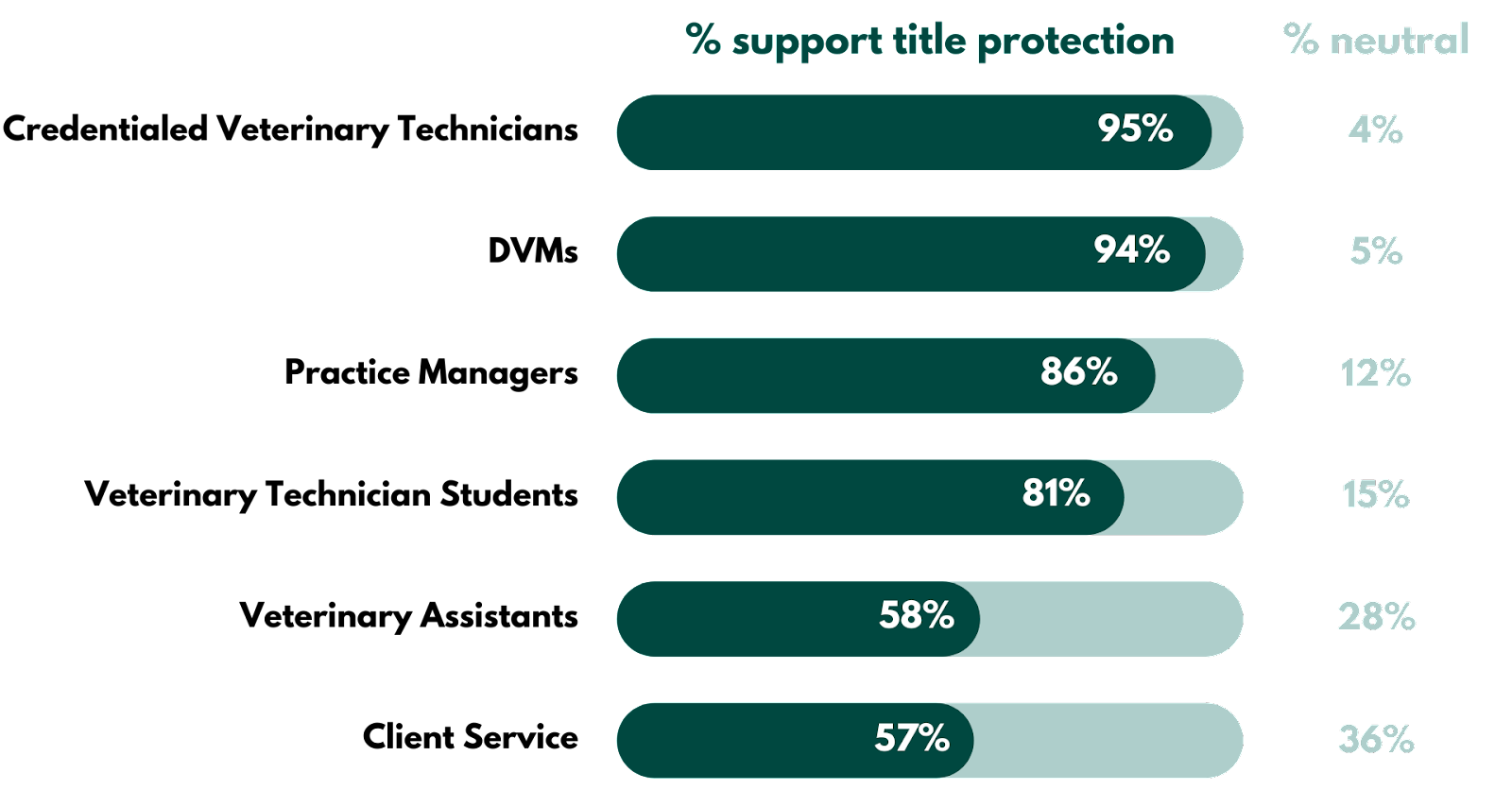
The industry as a whole wants this — so let’s get it done.
To do so, NAVTA provided some clear guidelines, as referenced below.
1. Establish and strengthen title protection in all states
With 31 states and jurisdictions currently without any level of title protection, the NAVTA Veterinary Nurse Initiative urges state regulatory bodies to establish title protection at the “general protection” level.
- In jurisdictions currently without regulation for veterinary technicians, efforts directed at establishing licensure, including language protecting “veterinary technician,” are needed.
(CO, CT, FL, MA, MN, NH, NJ, Puerto Rico, RI, VT, WY) - In jurisdictions currently regulating veterinary technicians without title protection, efforts directed at establishing title protection by amending the current laws to protect “veterinary technician” as a title are needed.
(AL, AR, AZ, DC, IA, KS, KY, ME, MS, NM, NC, ND, OH, OR, SC, SD, VA, WA, WI) - In states currently regulating veterinary technicians with limited protection, efforts directed at strengthening title protection by amending the current laws to protect “veterinary technician” and/or to establish general protection.
(IL, LA, MD, MI, MO, NE, PA, TX, UT, WV) - In states that do not protect the credential abbreviation for veterinary technicians, efforts directed at strengthening title protection by amending the current laws to protect “CVT”, “LVT”, or “RVT” respective to their state’s credential are needed.
(all states aside from CA, HI, IL, IN, LA, MO, OK, PA, TX, WV)
Increasing awareness of the veterinary technician profession is of necessity to increase the standard of care. Highlighting the educational requirements of veterinary technicians, along with economic and case management statistics that support the vital role the veterinary technician provides in the clinical setting, will encourage more interest by legislators.
State veterinary technician associations should form collaborative relationships with state veterinary medical boards and state veterinary medical associations to advocate for legislative changes necessary to institute stronger title protection within their state. Veterinary professionals (veterinary technicians and veterinarians) should join their state and national advocacy organizations to create a collective voice to urge legislative change.
2. Establish a Clear Policy for Enforcement of Title Protection Laws in All States
Effective collaboration between political leaders at the national, state, and local levels of authority in developing, promoting, and enforcing the protection of the veterinary technician profession is required in order to bring stronger sanctions to the table for those acting as veterinary professionals and performing medical care without a license.
The state veterinary medical boards must regulate and enforce the practice acts in order to protect the public from unqualified individuals. With the varying levels of veterinary technician acknowledgment within the practice acts, along with varying levels of title protection, making recommendations for practice act amendments to be very clear about different titles and roles of each member of the team are required.
What are some way this can be implemented?
- Awareness campaigns: State veterinary medical boards can raise awareness of existing title protection laws within the veterinary community to help prevent violations through their websites, notifications, letters, newsletters, and other communication avenues. The communication will encourage members of the profession, who currently do not notify the board because they feel it would not make a difference, to submit reports.
- Anonymous reporting methods: To increase oversight and enforcement of proper title usage and protection, anonymous reporting methods in which the evidence is provided upfront (e.g. improper use of titles on the website, name tags, scrub embroideries) are needed.
- Whistleblower policies: Consider implementing whistleblower policies to protect the complainant where state law allows.
- Educational resources: To encourage proper use of titles, dissemination of educational material to all state licensees, notifying them of the practice act language and the established penalties for title protection violations is vital. Educational materials can be distributed to licensees indirectly through email lists and/or directly during the time of license renewal as an acknowledgment that the information was read and understood.
- Clear penalties: Establishing clear penalties could also help improve compliance in combination with the exercising of general disciplinary actions. There are currently only five states with practice act language establishing clear penalties for title protection violation.
d. Extend the allowed functions of credentialed technicians in practices
Across the board, our industry should re-evaluate how we’re utilizing our highly-trained, credentialed technicians.
And that begins with team-based veterinary care.
“Team-based health care delivery led by veterinary technicians is key to our professions keeping up with the ever-growing demand for veterinary services.
All other health care professions have adopted a team-based delivery model. Our profession has been late to the party.
By empowering veterinary technicians, everyone wins - pets, clients, vet techs/nurses, doctors, teams, and the bottom line.”
For this to work, we’ll need to get strategic on how we create career paths & incentivize technicians along the way.
Amy Ramirez digs into this a bit more and how they do this at Blue Pearl Veterinary Partners today.
“For example, we have different knowledge and skill expectations for a technician who has just completed their degree program than we do for a technician who has worked within our hospital as a credentialed technician for a decade and is congruently pursuing veterinary technician specialty credentials.
We value the creation of sustainable careers that allow individuals to pursue career pathing based on their investment in knowledge, acquisition of new skills, and self-development.
We want to ensure that every technician and assistant is working to the top of their credentials, with pay ranges that accurately reflect the individual's investment in professional growth and the achievement of additional credentials within our profession.”
So, how do we do this in practice?
- Create clear pay & title bands that coincide with credentialing & experience (Associate vs. Senior Veterinary Technician)
- Offer credentialing & specializing scholarships (without weird non-compete or “catches”)
Create clear responsibility & accountability guidelines based on the above bands (For example: once they hit a certain level, they’re empowered to handle all routine appointments on their own)
e. Potentially create a new advanced practice professional role
There are quite a few proponents of this idea in vet med today.
One of the biggest proponents of this idea is Kenichiro Yagi, Chief Veterinary Nursing Officer at Veterinary Emergency Group.
“We have the potential to develop a Nurse Practitioner (NP) or Physician’s Assistant (PA) role with expanded scope of practice into diagnosis, prescription, and some surgery as a package through a certification process.
This can serve as a way to expand on the career pathway in veterinary nursing that will lead to increased fulfillment and retention of the best and brightest in our field.”
So, how do we standardize this role? Ken expands on this.
“Based on the agreed upon scope of practice assigned to the role, educational requirements will need to be determined. The curricula designed to deliver the content meeting the educational requirements should meet accreditation standards established by an authority.
A standardized examination process validating the individual's knowledge and skills should be developed to issue a certification for the professional. The certification then can be adopted by state veterinary boards to grant the license and ability to practice with an expanded scope of practice. Organizations and state veterinary boards should come to a consensus on each of the elements from the onset.”
"We should all be focusing on maximizing the utilization of veterinary technicians and nurses within the current scope of practice TODAY. Technicians and nurses can already do everything except diagnosis, prescription and surgery. It means we should be assessing the patient to determine the problem list to recommend diagnostics to the doctor. We can then perform and interpret diagnostic results to create treatment recommendations that the doctor considers. We then carry out the approved treatments. This will help maximize the efficiency and reach of the entire veterinary team. This should be happening regardless of the advent of an advanced practice role in veterinary medicine."
What benefits can we expect if we fix these issues?
“Once we clearly identify roles and what each member is trained and legally designated to perform within State Practice Acts, we can follow known, successful business models that create work environments that support team member success and growth, optimal care for our animal patient, and healthy businesses that can provide more access to veterinary care for clients.
In other words, once we identify the role of each team member, the team can use their better understanding of roles to build efficiency into everything they do for their patients, and at the same time they can support each team member's role and goals by providing well designed continuing education opportunities and pathways for growth.
Once everyone understands how they fit into the structure of veterinary team member titles and roles, it will also help relieve confusion and the frustration that results when there is a lack of clarity. Not only can we have practices that are more effective in providing great care for their patients, but they can also be more profitable and experience a better culture.”
TBH, Peg gets it. If we come together and really pull this off, we could see a lot of benefits to the industry, both qualitative (things like employee satisfaction) and quantitative (that cash money 🤑)
Below, Bob Lester lists a few of these potential benefits:
- Ability to help more pets
- Get home on time (occasionally)
- Improved medical outcomes
- Lower barriers to care; more available and affordable care
- Retention improvements for both vet techs, DVMs, and other team members
- Increased team member engagement
- Improved client engagement
- Decrease burnout, compassion fatigue, and wellness issues
- Improved hospital efficiency leading to better profitability
- Increased compensation and benefits from efficiencies
- Limits non-veterinary professionals providing care
- Doctors freed up to provide more advanced care needs
To dig in further on these tangible benefits, we broke them down into 3 sections.
1. Better Employee Experience
Remember all the talk about team culture above? Well, if we start to put the work in, so will our employees — and they’ll love the work they do.
a. Lower employee burnout
The Merck Veterinary Well-Being Study made it clear that our industry is burned out.

Nearly half of veterinary staff are highly burnt out.
But, we also know from our culture research above that what makes our employees happier at work is employee engagement. And we can do that by optimizing our team.
“There are endless opportunities to optimize credentialed techs and the benefits reach far beyond just the financial side of the practice.
Improving the team's engagement, increasing DVM productivity, stabilizing retention rates, and maximizing team potential are all by-products of what we would expect to see.”
b. Ownership over work
This also bleeds over into the separation of the assistant and technician roles. As Peg Wheeler had highlighted, once we separate and celebrate those roles, our people will feel more ownership & autonomy over their work.
“Another benefit of optimizing the use of technicians is by better utilizing assistants as well. Many schools are now offering courses for tech assistants as a career path. Elevating the technician role will ultimately elevate your technician assistants as well, and that is something everyone will benefit from.”
2. Increased Practice Revenue
a. Better veterinarian utilization
Veterinary technicians performing at the top of their license allow Veterinarians to perform at the top of theirs. By delegating work to technicians and more effectively utilizing veterinarians, practices are able to significantly increase profits profitability.
"In support of the profitability a veterinary practice can achieve by leveraging members of a veterinary practice, a survey conducted in 2008 found that for every credentialed veterinary technician a practice employed, the clinic generated $161,493 more in gross revenue.
The study attributed the increase to freeing up the veterinarian’s time by allowing qualified technicians to complete tasks veterinarians traditionally performed."
b. Lower staffing costs
Recruiting, onboarding, and training is significantly more costly to business than employee retention. To reduce staffing costs, focus on reducing turnover. In today’s market with a shortage of workers, it’s becoming more and more difficult and costly to recruit. The workers you have in your practice already are your greatest asset - invest in keeping them satisfied and productive!
“With pet ownership on the rise, veterinary clinics need to be as productive as ever. Retaining talent became even more important than attracting new employees, and we simply can’t afford under-utilizing technicians.
One of, if not the highest operational expense in the hospital is staffing. Losing a good technician based on the fact that they are bored or not being challenged enough in their role is something that we can’t sustain in any hospital.”
3. Increased Access to Veterinary Care
a. Retain veterinary talent in the industry
Remember those graphs above showing the gap in veterinary care by 2030?
Well, if we fix some of these issues, which helps us empower & retain our people — that means more veterinary workers to care for the increasing number of pet households.
This retention helps all aspects of the business, as Bob Murtaugh notes.
“Less attrition from the practice and profession brings happier clients and teams, healthier patients, and increased revenue and rewards for the practice owner and team.”
b. Increased practice efficiency
Increasing practice efficiency also directly leads to an increase in access to care.
“Optimizing the use of technicians equals optimizing scheduling. Credentialed techs are more than capable of handling appointments that are appropriate for them to take on.
Just think of what that schedule could look like if your techs were able to take on some of these revenue-generating appointments such as a booster vaccine?
The ERs are slammed and your DVMs need to open up some capacity to see these urgent cases. Transferring some of this responsibility to technicians is a great way to utilize their skills, relieve some of that schedule crunch from your DVMs, and satisfy your clients needs.”
Let’s make a better, brighter future for our veterinary technicians.
Our veterinary technicians deserve better.
Sure, some of the challenges we face are big and can seem daunting.
But, we must face them head-on, and, if we do, we’ll retain our highly-skilled talent and will come out of this stronger as an industry.
We owe it to our people to try — and to put them first. ❤️




